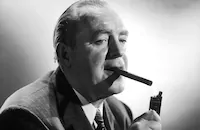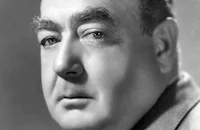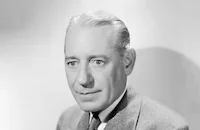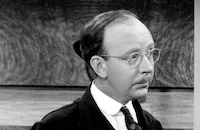I've Got Your Number

Brief Synopsis
Cast & Crew
Ray Enright
Joan Blondell
Pat O'brien
Allen Jenkins
Glenda Farrell
Eugene Pallette
Film Details
Technical Specs

Synopsis
Fed up with telephone repairman Terry Riley's sarcastic attitude, his boss, Joe Flood, vows to give him every dirty job that is called in and one day sends him to a fire to rescue an endangered cable. During the fire, Terry saves the life of businessman John P. Schuyler, and out of gratitute, Schuyler promises his help if Terry should ever need it. Then Terry and his partner, John, reveal a fortune-teller, Bonnie, to be a fake. Shortly afterward, Bonnie and John start to date. Meanwhile, at a nearby hotel, switchboard operator Marie Lawson agrees to help hotel guest Nicky play a joke on businessman Tully, another guest. Actually, Nicky takes a call pretending to be Tully and uses the information he receives illegally. When Tully complains to the manager because he lost a lot of money, the manager calls the phone company to determine if the line was tapped. Terry is assigned the job. He is very attracted to Marie and tries to make a date with her, but she turns him down. After he discovers that the line is clean, Marie is fired. Eventually Terry convinces her to have dinner with him. After learning that she was fired, he remembers Schuyler's offer and contacts him. Schuyler agrees to hire Marie, and to celebrate, Terry and Marie have dinner together. At the restaurant, Marie meets a girl friend and her date. The man is very interested to hear about Marie's new job, and the next day, he and his partner, Nicky, show up at Schuyler's office. While the friend distracts Marie with phony telephone calls, Nicky signs for bonds that are supposed go to Schuyler. As soon as Marie realizes what has happened, she runs after Nicky. Schuyler naturally thinks that she is part of the gang that robbed him. Terry is convinced of her innocence, however, and when she calls him asking him to meet her, he leaves immediately. Unknown to him, Schuyler's detectives follow him, and just after she tells her story to Terry, the district attorney arrests her. Terry traces the calls, which lead him to Nicky's hideout, and Terry's partner, John, stays behind to monitor the line. Terry is caught by the crooks, who lock him in a room after ripping out the phone. Terry taps directly into the line, however, and John overhears the criminals' threats. He rouses the other telephone men, who all rush to the hideout and save Terry. After the police arrest the criminals, Terry and Marie get married and are teased on their wedding night by Terry's fellow repairmen.

Director
Ray Enright
Cast

Joan Blondell

Pat O'brien

Allen Jenkins

Glenda Farrell

Eugene Pallette
Gordon Westcott

Henry O'neill

Hobart Cavanaugh
Renee Whitney
Wallis Clark
Robert Ellis
Douglas Cosgrove
Selmar Jackson

Louise Beavers

Henry Kolker
Charles Wilson
Tom Costello

Clay Clement
Crew

Film Details
Technical Specs

Articles
I've Got Your Number
Many romantic comedies at the time were loaded with sexual innuendo, and this one was no exception as the film is crammed with nudging puns. In its original scripted form, the dialogue ran into trouble with the Production Code Administration thanks to its recurring fascination with characters being smacked on the rear end, a common ploy for laughs at the time. References to "fanny slapping" had to be dropped along with any onscreen "slap of the posterior," per the Code's verdict in a November, 1933 letter to the studio. Also censored were more suggestive lines about a "long telephone cord," shots of Blondell in sheer clothing "showing body contours," and the saucy line, "I meant to pat her on the shoulder - but she bent over." Though still cheeky in its final form, the film continued to run into trouble with censors elsewhere; Australia, one of the strictest English-speaking markets, even insisted on deleting "views of Joan Blondell rearranging pillows on a bed."
A prolific actress, Blondell worked with James Cagney seven times during their tenure together at Warner Bros. (whom she left in 1939). At the time of this film she was married to her first husband, cinematographer George Barnes; the union was a turbulent one and would end in 1936. The shooting of this film was complicated by Blondell's health issues, and according to Matthew Kennedy's biography, Joan Blondell: A Life Between Takes, she suffered a bout of peritonitis brought on by private medical procedures near the end of filming.
By December of 1933, Blondell was bedridden and unable to shoot a final scene needed for the project at the studio, so the cast and crew came to film at her house instead. (See if you can spot the scene!) Jack Warner wound up placing her on temporary suspension, but her personal life was complicated further by hospitalization shortly afterwards and a severe house fire that destroyed the bulk of her personal belongings. Undaunted, Blondell carried on like a pro with four more films in 1934 including another Busby Berkeley musical, Dames, and the bizarre spousal abuse comedy Smarty. I've Got Your Number marked the second credited teaming of Blondell and actress Glenda Farrell after the 1933 comedy Havana Widows. Best known to audiences as the long-running intrepid reporter Torchy Blane, Farrell (who plays bubble-headed medium Bonnie) reunited with Blondell six more times including such films as Miss Pacific Fleet (1935) and their most popular pairing as two of the Gold Diggers of 1937 (1936). Along with the magic Farrell touch, the film also features an array of familiar supporting faces like Henry O'Neill, Louise Beavers, Allen Jenkins, and "Friar Tuck" himself, Eugene Pallette, who would go on to character actor immortality in The Adventures of Robin Hood (1938) and Mr. Smith Goes to Washington (1939).
Though her pairing with Farrell is more famous, Blondell also went on to work with busy tough guy Pat O'Brien several more times as well after this first feature together. They appeared in two reporter-themed films, Back in Circulation (1937) and Off the Record (1939), though their strangest collaboration came years later when they both appeared in the oddball cult rock 'n' roll/spy comedy The Phynx (1970).
A successful release for Warner Bros., I've Got Your Number was praised by Variety as "a corking good comedy in its class" that "packs a bale of laughs." The studio was turning out farces like these at a rapid clip, and its disposable nature at the time is obvious in the appraisal that this is "one of those pictures they'll laugh at and promptly forget. But they'll laugh." Fortunately, they still do.
By Nathaniel Thompson

I've Got Your Number
Quotes
Trivia
The ending, with Joan Blondell in bed, was filmed in her home. She was recovering from an emergency appendectomy and her doctor would not let her travel to the studio.
Notes
A news item in Film Daily notes that Ben Markson was assigned to the screenplay; however his participation in the final film has not been confirmed. According to a news item in Daily Variety, a bedside scene between Joan Blondell and Pat O'Brien was filmed at her home because her physician would not allow the actress, who was recovering from an emergency appendectomy, to travel to the studio. The film's pre-release title was Hell's Bells.















